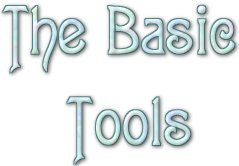![]()
Home Tutorial Mods Configurator Bookstore Links Email JPDeni
![]()

![]()
As with any project, you need to start by gathering your tools. DBMan is no different. You don't have to use all of the things I suggest here, but if you do things will go much more smoothly.The first thing you need, naturally, is a copy of the DBMan distribution. You can pick it up right here.
The file is in a .zip format, so you will need something like WinZip or pkunzip to unpack the files onto your hard drive.
You will need to do some editing of the files before you can use them. It is possible to edit the files in a generic text editor, but if you are planning to do any custom scripting or adding modifications, it would be better to use a text editor that is designed for programmers. Programmer's File Editor is a very good freeware editor. EditPlus is even better and the shareware fee is only $30.
Whatever you do, DO NOT use any kind of word processor program or even programs like Notepad or Wordpad. They add formatting characters to the files which cause scripts to crash. If you are in doubt about whether your program is suitable, here's a little trick. If the program allows you to add bold formatting to text, do not use it. Find something else.
You will need a way to upload the files to your server. I use CuteFTP, but there are a number of other very good FTP clients availabe, including wsFTP and Bulletproof.
Although not technically "tools," you will also need to have some information about your server. Contact your server administrator and find out the following:
- Can you run cgi scripts on your server?
- If the answer is "No," you don't need to go any further. You must be able to run cgi scripts to use DBMan. You might try to find a freeware server that will allow you to install cgi scripts.
- What is the URL of your cgi-bin?
- On some systems, such as Windows systems, you can place your cgi scripts in any directory. Unix systems usually require you to place the scripts in a cgi-bin.
- What is the path to Perl on your system?
- Again, Windows systems do not require you to specify the path to Perl, but if you're on a Unix system, you will need to know this.
- What version of Perl is on the system?
- Your server need to have at least version 5.003 to run DBMan. If your administrator tells you that the server has a number lower than this, ask (nicely!) for them to upgrade their version of Perl.
- Where is sendmail on your system? (optional)
- You might not need to know this, but if you are thinking about adding any modification which sends email either to the database administrator or to users, you will need to know where sendmail is. Since you're asking questions anyway, you might as well ask this one too.
![]()
Optional tools
An optional tool to have on your home computer is the ActiveState version of Perl. It is free and installation is a snap. It will come in handy when you are editing the files and need to find out where you have made a syntax error. (And it is almost guaranteed that sometime or another you will make a syntax error.) If you use EditPlus, you can set it up to check for syntax errors while you are still within the editor. (Tutorial on this coming soon.)Another option is to install server software on your home computer. The advantage of having your own server software is that you can test the script before you upload it to your webspace. Sometimes working with the server is a little hairy, though. I'll be working on some tutorials for dealing with server software in the future. If you do install a server on your home computer, you will need to also install Perl as described in the previous paragraph. (I hope to have tutorials on installing several different servers soon.)
| The basic tools | |||
| Install the demo | |||
| Create your own configuration | |||
| Set permissions | |||
![]()
Home Tutorial Mods Configurator Bookstore Links Email JPDeni![]()